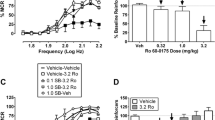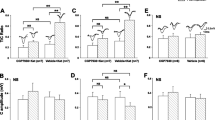Summary
In vivo microdialysis was used to determine the effects of chronic electroconvulsive shock (ECS), given daily for 10 days, on basal 5-HT levels in rat frontal cortex and hippocampus and on the effect of systemic administration of the 5-HT-la receptor agonist, 8-OH-DPAT (0.2 mg/kg), to reduce 5-HT levels in these areas by activation of somatodendritic autoreceptors. Neither basal 5-HT levels nor the effects of 8-OH-DPAT on 5-HT levels were altered after chronic ECS. The effect of systemic administration of the 5-HT1A and 5-HT1B antagonist, (±)-pindolol (10mg/kg), to increase 5-HT levels in hippocampus, was also not affected by chronic ECS.
Similar content being viewed by others
References
Abel MS, Clody DE, Wennogle LP, Meyerson LR (1985) Effect of chronic desmethylimipramine or electroconvulsive shock on selected brain and platelet neurotransmitter recognition sites. Biochem Pharmacol 34: 679–683
Assie M-B, Koek W (1996) (−)-Pindolol and (±)-tetatolol affect rat hippocampal 5-HT levels through mechanisms involving not only 5-HT1A, but also 5-HT1B receptors. Neuropharmacology 35: 213–222
Auerbach SB, Hjorth S (1995) Effect of chronic administration of the selective serotonin uptake inhibitor citalopram on extracellular 5-HT and apparent autoreceptor sensitivity in rat forebrain in vivo. Naunyn Schmiedebergs Arch Pharmacol 352: 597–606
Bel N, Artigas F (1993) Chronic treatment with fluvoxamine increases extracellular serotonin in frontal cortex but not in raphe nuclei. Synapse 15: 243–245
Blier P, Bouchard C (1992) Effect of repeated electroconvulsive shocks on serotonergic neurons. Eur J Pharmacol 211: 365–373
Blier P, de Montigny C (1994) Current advances and trends in the treatment of depression. Trends Pharmacol Sci 15: 220–226
Bosker FJ, Donker MG, Klompmakers AA, Kurata K, Westenberg HGM (1994) 5-hydroxytryptamine release in dorsal hippocampus of freely moving rats: modulation by pindolol. Prog Neuropsychopharmacol Biol Psychiatry 18: 765–778
Bosker FJ, van Essevelt KE, Klompmakers AA, Westenberg HGM (1995a) Chronic treatment with fluvoxamine by osmotic minipumps fails to induce persistent functional changes in central 5-HT1A and 5-HT1B receptors, as measured by in vivo microdialysis in dorsal hippocampus of conscious rats. Psychopharmacology 117: 358–363
Bosker FJ, Klompmakers AA, Westenberg HGM (1995b) Effects of single and repeated oral administration of fluvoxamine on extracellular serotonin in the median raphe nucleus and dorsal hippocampus of the rat. Neuropharmacology 34: 501–508
Burnet PWJ, Mead A, Eastwood SL, Lacey K, Harrison PJ, Sharp T (1995) Repeated ECS differentially affects brain 5-HT1A and 5-HT2A receptor expression. NeuroReport 6: 901–904
Casanovas JM, Artigas F (1996) Differential effects of ipsapirone on 5-hydroxy-tryptamine release in the dosal and median raphe neuronal pathways. J Neurochem 67: 1945–1952
Chaput Y, de Montigny C, Blier P (1991) Presynaptic and postsynaptic modifications of the serotonin system by long-term administration of antidepressant treatments: an in vivo electrophysiological study in the rat. Neuropsychopharmacology 5: 219–229
Cheetham SC, Viggers JA, Slater NA, Heal DJ, Buckett WR (1993) [3H]Paroxetine binding in rat frontal cortex strongly correlates with [3H]5-HT uptake: effect of administration of various antidepressant treatments. Neuropharmacology 32: 737–743
de Montigny C (1984) Electroconvulsive shock treatments enhance responsiveness of forebrain neurons to serotonin. J Pharmacol Exp Ther 238: 230–234
Dreshfield LJ, Wong DT, Perry KW, Engleman EA (1996) Enhancement of fluoxetme-dependent increase of extracellular serotonin levels by (−)pindolol, an antagonist at 5-HT1A receptors. Neurochem Res 21: 557–562
Evans JPM, Grahame-Smith DG, Green AR, Tordoff AFC (1976) Electroconvulsive shock increases the behavioural responses of rats to brain 5-hydroxytryptamine accumulation and central nervous system stimulant drugs. Br J Pharmacol 56: 193–199
Gleiter CH, Nutt DJ (1988) Repeated electroconvulsive shock does not change [3H]paroxetine binding to the 5-HT uptake site in rat cortical membranes. Psychopharmacology 95: 68–70
Goodwin GM, de Souza RJ, Green AR (1985) Presynaptic serotonin receptor-mediated response in mice attenuated by antidepressant drugs and electroconvulsive shock. Nature 317: 531–533
Goodwin GM, de Souza RJ, Green AR (1987) Attenuation by electroconvulsive shock and antidepressant drugs of the 5-HT1A receptor-mediated hypothermia and serotonin syndrome produced by 8-OH-DPAT in the rat. Psychopharmacology 91: 500–505
Green AR, Johnson P, Nimgaonkar VL (1983) Increased 5-HT2 receptor number in brain as probable explanation for the enhanced 5-hydroxytryptamine-mediated behaviour following repeated electroconvulsive shock administration to rats. Br J Pharmacol 80: 173–177
Green AR, Heal DJ, Vincent ND (1987) The effects of single and repeated electroconvulsive shock administration on the release of 5-hydroxytryptamine and noradrenaline from cortical slices of rat brain. Br J Pharmacol 92: 25–30
Hayakawa H, Yokota N, Shimizu M, Nishida A, Yamawaka S (1993) Repeated treatment with electroconvulsive shock increase numbers of serotonin 1A receptors in the rat hippocampus. Biogen Amines 9: 295–306
Hayakawa H, Shimizu M, Nishida A, Motohashi N, Yamawaka S (1994) Increase in serotonin 1A receptor in the dentate gyrus as revealed by autoradiographic analysis following repeated electroconvulsive shock but not imipramine treatment. Neuropsychobiology 30: 53–56
Hayakawa H, Okamoto Y, Shimizu M, Nishida A, Motohashi N, Yamawaka S (1995) Single or repeated treatment with electroconvulsive shock increases number of serotonin uptake binding sites in the frontal cortex. Neuropsychobiology 31: 1–5
Hjorth S (1993) Serotonin 5-HT-la autoreceptor blockade potentiates the ability of the 5-HT reuptake inhibitor citalopram to increase nerve terminal output of 5-HT in vivo: a microdialysis study. J Neurochem 60: 776–779
Hjorth S (1996) (−)Pindolol, but not buspirone, potentiates the citalopram-induced rise in extracellular 5-hydroxytryptamine. Eur J Pharmacol 303: 183–186
Hjorth S, Sharp T (1991) Effect of the 5-HT receptor agonist 8-OH-DPAT on the release of 5-HT in dorsal and median raphe-innervated rat brain regions as measured by in vivo microdialysis. Life Sei 48: 1779–1786
Hjorth S, Sharp T (1993) In vivo microdialysis evidence for central serotonin-lA and serotonin-lB autoreceptor blocking properties of the beta adrenoceptor antagonist (−)penbutolol. J Pharmacol Exp Ther 265: 707–712
Hjorth S, Auerbach SB (1994) Lack of 5-HT1A autoreceptor desensitization following chronic citalopram treatment, as determined by in vivo microdialysis. Neuropharmacology 33: 331–334
Invernizzi R, Carli M, di Clemente A, Samanin R (1991) Administration of 8-hydroxy-2-(di-n-propylamino)tetralin in raphe nucleus dorsalis and medianus reduces serotonin synthesis in the rat brain: differences in potency and regional sensitivity. J Neurochem 56: 243–247
Invernizzi R, Bramante M, Samanin R (1994) Chronic treatment with citalopram facilitates the effect of a challenge dose on cortical serotonin output: role of presynaptic 5-HT1A receptors. Eur J Pharmacol 260: 243–246
Invernizzi R, Bramante M, Samanin R (1995) Extracellular concentrations of serotonin in the dorsal hippocampus after acute and chronic treatment with citalopram. Brain Res 696: 62–66
Kellar KJ, Cascio CS, Butler JA, Kurtzke RN (1981) Differential effects of electroconvulsive shock and antidepressant drugs on serotonin-2 receptors in rat brain. Eur J Pharmacol 69: 515–518
Kreiss DS, Lucki I (1994) Differential regulation of 5-HT release in the striatum and hippocampus by 5-HT1A autoreceptors of the dorsal and median raphe nuclei. J Pharmacol Exp Ther 269: 1268–1278
Kreiss DS, Lucki I (1995) Effects of acute and repeated administration of antidepressant drugs on extracellular levels of 5-HT measured in vivo. J Pharmacol Exp Ther 274: 866–876
Minchin MCW, Williams J, Bowdler JM, Green AR (1983) Effect of electroconvulsive shock on the uptake and release of noradrenaline and 5-hydroxytryptamine in rat brain slices. J Neurochem 40: 765–768
Moret C, Briley M (1996) Effects of acute and repeated administration of citalopram on extracellular levels of serotonin in rat brain. Eur J Pharmacol 295: 189–197
Nowak G, Dulinski J (1991) Effect of repeated treatment with electroconvulsive shock (ECS) on serotonin receptor density and turnover in the rat cerebral cortex. Pharmacol Biochem Behav 38: 691–694
Pandey SC, Isaac L, Davis JM, Pandey GN (1991) Similar effects of treatment with desipramine and electroconvulsive shock on 5-hydroxytrytamine 1A receptors in rat brain. Eur J Pharmacol 202: 221–225
Pineyro G, Castanon N, Hen R, Blier P (1995) Regulation of [3H]5-HT release in raphe, frontal cortex and hippocampus of 5-HT1B knock-out mice. NeuroReport 7: 353–359
Rutter JJ, Gundla C, Auerbach SB (1994) Increase in extracellular serotonin produced by uptake inhibitors is enhanced after chronic treatment with fluoxetine. Neurosci Lett 171: 183–186
Schoups AA, Beeckman N, Lauwers M-C, de Potter WP (1988) Evaluation of the role of pre- and postsynaptic serotonergic receptors in electroconvulsive shock therapy. Biol Psychiat 23: 807–817
Sleight AJ, Smith RJ, Marsden CA, Palfreyman MG (1989) The effects of chronic treatment with amitriptyline and MDL 72394 on the control of 5-HT release in vivo. Neuropharmacology 28: 477–480
Stockmeier CA, Kellar KJ (1986) In vivo regulation of serotonin-2 receptor in rat brain. Life Sci 38: 117–127
Stockmeier CA, Wingenfeld P, Gudelsky GA (1992) Effects of repeated electroconvulsive shock on serotonin 1A receptor binding and receptor-mediated hypothermia in the rat. Neuropharmacology 31: 1089–1094
Vetulani J, Lebrecht U, Pilc A (1981) Enhancement of responsiveness of the central serotonergic system and serotonin-2 receptor density in rat frontal cortex by electroconvulsive treatment. Eur J Pharmacol 76: 81–85
Yoshioka M, Matsumoto M, Numazawa R, Togashi H, Smith CB, Saito H (1995) Changes in the regulation of 5-HT release by α2-adrenoceptors in the rat hippocampus after long-term desipramine treatment. Eur J Pharmacol 294: 565–570
Zis AP, Nomikos GG, Damsma G, Fibiger HC (1991) In vivo neurochemical effects of electroconvulsive shock studied by microdialysis in the rat striatum. Psychopharmacology 103: 343–350
Zis AP, Nomikos GG, Brown EE, Damsma G, Fibiger HC (1992) Neurochemical effects of electrically and chemically induced seizures: an in vivo microdialysis study in the rat hippocampus. Neuropsychopharmacology 7: 189–195
Author information
Authors and Affiliations
Rights and permissions
About this article
Cite this article
Gur, E., Lerer, B. & Newman, M.E. Chronic electroconvulsive shock and 5-HT autoreceptor activity in rat brain: an in vivo microdialysis study. J. Neural Transmission 104, 795–804 (1997). https://doi.org/10.1007/BF01285548
Received:
Accepted:
Issue Date:
DOI: https://doi.org/10.1007/BF01285548




